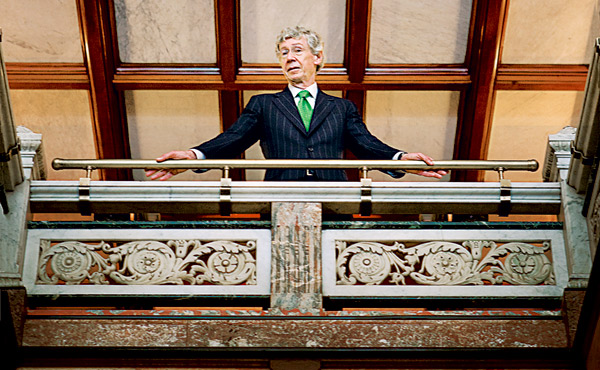
“It’s my gift to the city,” says Driehaus, pictured in the second-floor hallway of the 1883 Nickerson mansion.
Richard Driehaus loves a party almost as much as he loves historic architecture.
At his recent birthday extravaganza, held at his baronial estate in Lake Geneva last July, the 65-year-old philanthropist rode in high atop an elephant, beaming and waving. The theme of the party was historic circuses, and he was dressed in a custom-tailored ringmaster’s costume.
“As I consider what lies ahead,” he told the thousand or so guests, “my larger interest is that the Driehaus legacy will be focused on historic preservation efforts, encouraging design competitions of architecture and landscape and supporting fashion and interior design.”
But Driehaus, the founder of Driehaus Capital Management, one of the city’s largest investment firms, is no ordinary preservationist. He is a man who can afford to indulge his passions—for art, for parties, but mainly for restoring historic architecture—on a boundless scale, as anyone who has visited his many residences and offices around the world can attest.
In the past two decades, Driehaus has emerged as one of Chicago’s most prominent advocates for historic preservation. He has also taken a leading role in encouraging the city and public institutions and groups to adopt a more design-centered approach to civic projects.
Now he is taking his commitment a step further with the Richard H. Driehaus Museum of Decorative Arts, a new institution housed in what has been called the most expensive residence ever built in Chicago. In many ways, the project is the culmination of Driehaus’s long-term love affair with the city and the 19th century.
“Richard’s an amazing person,” says David Bahlman, the president of the Landmarks Preservation Council of Illinois. “The causes he supports and the projects he has funded over the years have had a great impact on the appreciation of art and architecture in Chicago.”
By focusing on high-profile projects that have an immediate impact, Driehaus has reinvigorated a preservation scene that many say was sunk in academic torpor. “You can go to him and get a fast turnaround,” says Tim Samuelson, the city’s cultural historian and a veteran of more than a few major preservation battles. “If you have a preservation crisis and are up against a team of high-powered developers, he provides you with the means to compete on an even level.”
An example is the recent brouhaha over Promontory Point, the Alfred Caldwell-designed lakefront landscape in Hyde Park. Driehaus’s funds allowed a citizens’ group to successfully challenge the city’s plans to pave over the original naturalistic breakfront.
In backing such efforts, he has at times courted controversy with his open dislike of modernism and his championing of the lively neoclassicism of the late 19th and early 20th centuries. For example, Driehaus refused to fight the recent preservation battle to save and restore the architect Ludwig Mies van der Rohe’s Farnsworth House in suburban Plano, by most accounts one of the Chicago area’s most important modernist structures. “The problem is there’s no poetry in modern architecture,” says Driehaus. “There’s money—but no feeling or spirit or soul. Classicism has a mysterious power. It’s part of our past and how we evolved as human beings and as a civilization. It’s more organic, more individual, and more interesting.”
In a city renowned as a modernist bastion, those would seem to be fighting words. Surprisingly, however, the critics—for the most part—have given him a pass. “I think what he’s doing is just short of God’s work,” says Lee Bey, the former architecture critic for the Chicago Sun-Times and currently the executive director of the Chicago Central Area Committee, a civic group committed to improving the city. “You take a stand where a stand needs to be taken. Somebody has to stand up for the classical buildings.”
“I have enormous respect and admiration for the way Richard has put his money where his mouth is in terms of trying to uplift design,” says Blair Kamin, the Chicago Tribune’s Pulitzer Prize-winning architecture critic. “I do think there is a modernist bias in a lot of architectural dialogue today, and the world does not live entirely in works that are avant-garde. Most Americans live in traditional buildings, and the more we understand traditional buildings and their language and nuances, the better off we are.”
Even Donna Robertson, the dean of the Illinois Institute of Technology’s architecture school, the unofficial Vatican of American modernism, endorses Driehaus. “For God’s sake,” she says, “there are enough people around here who are interested in modernism. It’s his money. Let him do with it what he wants.”
Despite his love of classicism, Driehaus has funded modern projects if they have raised the general level of design while fulfilling their basic missions. In the late 1990s, he sponsored an international competition for IIT that resulted in the new Rem Koolhaas–designed student center. (He demurs when asked what he thinks of the building.) In the same period, he funded a second international competition that led to the selection of the modernist landscape architect Kathryn Gustafson to design the Lurie Garden in Millennium Park.
* * *
Photography: William Zbaren
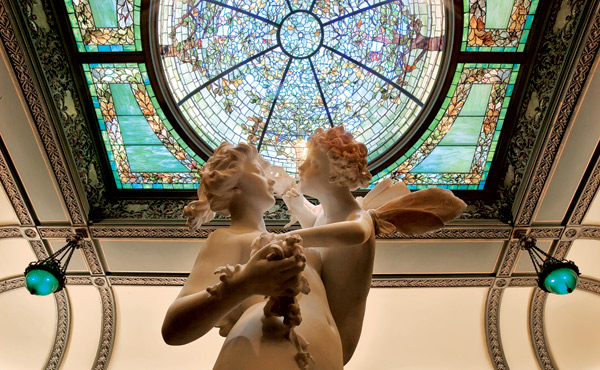
A 19th-century Roman rendering of Cupid and Psyche stands beneath an art-glass dome in the sculpture gallery.
This fall, however, the spotlight is on the museum, which will open in late October, initially by appointment only. “It’s my gift to the city,” Driehaus says. “The museum is about protecting the past. The idea is to display the period, the materials and objects, and to organize that as a whole experience. It’s not about any one object. It’s about the environment, the space.”
Samuel Nickerson, the founder of the First National Bank of Chicago, was one of the city’s leading plutocrats in the era between the Great Chicago Fire of 1871 and the 1893 World’s Columbian Exposition. In 1883, he commissioned the architectural firm of Burling & Whitehouse to design a house commensurate with his position and also to display his extensive art collection.
The site was several blocks west of what is now Michigan Avenue in a section of the city then known as McCormickville, so named because a number of the members of the McCormick family also lived in the area. (The last remaining McCormick residence is the Robert H. McCormick house, located steps away from the Nickerson at the corner of Erie and Rush streets.)
The cost for the three-story, 24,000-square-foot mansion was $450,000, a fantastic amount and equivalent on a square-foot basis to what East Coast swells like the Vanderbilts and the Rockefellers were spending on their houses in the same period. The cost today would be more than $100 million.
“It’s one of the grandest 19th-century houses in the country,” says Kirby Talley, the Amsterdam-based curator and author whom Driehaus hired in the fall of 2003 to oversee the restoration. “It doesn’t get any better than this.”
The Nickersons moved out in 1900 after selling the house and most of the original furnishings to Lucius Fisher, a paper-bag manufacturer and the developer of the Fisher Building in the Loop. (The price, reflecting both the decline of the neighborhood and the persistent economic recession that gripped Chicago in the aftermath of the Columbian Exposition, was $75,000.) When Fisher’s heirs decided to sell in 1919, they sparked what Tim Samuelson says was the city’s first successful preservation effort. “Even in its day,” he says, “the Nickerson house was regarded as something special.”
Fearing that it might be demolished, a group of friends and neighbors that included such prominent Chicago figures as William Wrigley, Cyrus McCormick, and Julius Rosenwald raised enough money to buy the house and donate it to the American College of Surgeons, a medical association, for use as its headquarters. In 1926, the college also constructed the John B. Murphy Auditorium next door.
In 1965, the college relocated but continued to own the property. For years, it was leased to a variety of tenants. Today, it is probably best remembered as the home of R. H. Love Galleries, an art gallery that occupied the house for 12 years before Driehaus bought it in 2003. (He declined to disclose what he paid for the house, and county records do not list a price.)
“I went over there one day with my friend Buzz Harper, an antiques dealer, to look at a bust of Abraham Lincoln I was thinking about buying,” Driehaus recalls. “Buzz took one look and said, ‘Forget the bust. Buy the house.’ It was like a light going off in my head. I suddenly started to see a lot of possibilities.”
By then, the house had an air of genteel decline. Outside, the buff-colored sandstone façade had turned a sooty black. The interior, meanwhile, was banged and chipped after decades of use as a commercial facility. The heating and cooling systems—not to mention the bathrooms—were antiquated. All of this has now been reversed, starting with the exterior, where lasers were used to remove a century’s worth of grime.
“It’s a method that is fairly common in Europe for cleaning sculpture, but I’m not aware that it has ever been used to clean an entire building,” says the architect Joseph Antunovich, who oversaw the restoration. “The whole project has been a labor of love on Richard’s part.”
“Brainstorming with Richard is like throwing gasoline on a fire,” Antunovich adds. “The ideas keep getting bigger and better. At times, you have to hold him back.”
* * *
Photography: William Zbaren
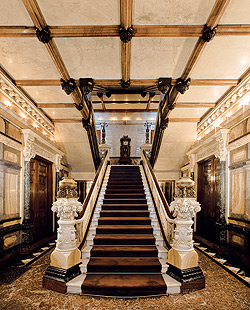
The grand staircase in the main hall on the first floor of the mansion; the clock at the top of the stairs belonged to Lucius Fisher, the second owner of the house. |
In the beginning, Driehaus says, the idea was simply to save and restore a remarkable historic house. Eventually, however, he realized that the residence would make an admirable repository for his collection—or, at least, part of his collection—of 19th-century art and decorative objects. Driehaus has one of the largest collections of Tiffany objects in the country, if not the world—dozens of rare windows, lamps, chandeliers, and tabletop pieces. These are displayed throughout the museum along with paintings, sculptures, and Herter Brothers furniture. (Herter Brothers was a celebrated New York interior design firm of the period whose furniture and decorative objects remain highly collectible.)
The museum is a stunner, starting with an imposing two-story entry hall and grand staircase that has the kind of lavish detailing one associates more with Renaissance palaces in Florence or Venice than with a Midwest boomtown like Chicago. The hall is flanked on both sides by a series of magnificent rooms that have been flawlessly restored to their original elegance. The dining room, for example, has elaborately embossed walls and an exuberant chandelier that incorporates wild boar heads, hunting horns, and brass arrows. The music room, meanwhile, has a rare 19th-century Chickering piano and walls covered in oyster, gold, and silver silk damask. Another highlight is the sculpture gallery, a two-story windowless space topped by a brilliantly colored art-glass dome. Positioned beneath the dome in a shaft of light is a dramatic 19th-century Roman sculpture of Cupid encountering Psyche, the Greek goddess of the soul. Upstairs are bedrooms and a third-floor ballroom that will be used for special exhibitions.
The opulence at times overwhelms. The entry hall alone features 17 kinds of marble. Throughout, there is a profusion of exquisite details and materials such as multicolored marble columns and balustrades, carved and inlaid wooden mantels (every room has a fireplace) and doorways, art-glass windows, decorative mosaics, and ornamental brass grilles and railings.
The overall effect is of being transported back in time to a period when no one doubted that more—rather than less—was more. This was when the rich really knew how to live. And, to a great degree, Driehaus lives that way today.
The offices of his financial firm as well as his myriad other activities sit diagonally across the street from the Nickerson in a compound that consists of two historic houses—the 1886 Ransom Cable mansion and a century-old brick townhouse that was formerly occupied by the architecture firm of Graham, Anderson, Probst & White. Additional office space is located in a modern high-rise nearby.
The compound and its elaborate garden are all viewable from the sidewalk and are a regular stop on walking tours of the North Side. On a given day, it is rare not to find a tourist or two posing for photos in front of the complex’s imposing iron gate, a sign that Driehaus takes as evidence that the public—if not always the critics—understands and embraces his vision. “There are modern buildings on all sides of us,” he says, “and you never see anyone getting their picture taken in front of those.”
The Cable, which Driehaus bought in 1987, became his first historic restoration project. The first floor consists largely of reception and meeting rooms, while the second is occupied primarily by Driehaus’s vast office and what must be one of the most unusual trading floors in Chicago. In a room dripping with Tiffany chandeliers and glistening with marble statuary, young traders stare intently at their screens,
monitoring the minute fluctuations in the world’s financial markets. “I think great art and architecture are ennobling,” Driehaus says. “I think they help people do their jobs a little better.”
They must. Driehaus’s firm—the earliest incarnation of which he founded in 1979—has been on a roll in recent years, racking up double-digit annual gains for its two principal mutual funds. The firm manages assets of about $4 billion.
* * *
Photography: William Zbaren
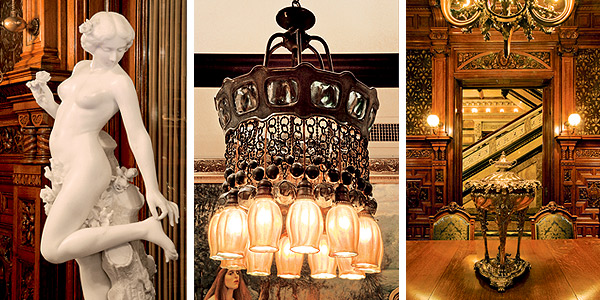
(Left) Woman with Rose Garlands, a late-19th-century sculpture in the dining room of the Nickerson mansion; (center) an early-20th-century Tiffany turtleback chandelier in Driehaus’s headquarters; (right) an early-20th-century silver punch bowl by Tiffany in the dining room.
The results have fueled both Driehaus’s lifestyle and his philanthropy. In addition to the 36-acre Lake Geneva estate (and the Nickerson, Cable, and century-old houses), he owns a beautifully renovated Gold Coast mansion that serves as his primary residence and houses in Nantucket and St. Thomas. He travels by private jet and dresses in Paul Smith suits and Dolce & Gabbana jeans.
Driehaus was married briefly in his early 50s, long enough to father two daughters. By all accounts, he is a doting parent. His Lake Geneva estate, for example, features a deluxe playground in the form of a carefully detailed child-size village, complete with houses, stores, and a working soda fountain.
The philanthropy starts with the Richard H. Driehaus Foundation, which has an endowment of more than $70 million and dispenses about $2.5 million a year in grants, most of which go to Chicago causes and institutions. About 60 percent of the grants are related to architecture and landscape design. Through an alliance with the John D. and Catherine T. MacArthur Foundation, Driehaus’s foundation also awards another $1 million a year in grants to community arts groups.
The foundation is very much a family affair. The board, which meets three times a year to discuss and approve initiatives, consists of Driehaus and his two younger sisters, Dorothy and Elizabeth.
“Our priority has been to see how architecture and design can benefit people who don’t normally have the benefit of those disciplines,” says Sunny Fischer, the foundation’s executive director since the early 1990s. “It’s the social aspects of architecture and design that interest us.” A case in point is another new museum the foundation is working on, the Public Housing Museum, which will be located on Taylor Street in the last remaining building of the Jane Addams Homes, a 1930s public-housing project. The museum is modeled on the Lower East Side Tenement Museum in New York, which uses public housing as a prism to examine a range of social and cultural issues, everything from immigration and racial segregation to attitudes about modern architecture.
“We’ve taken the lead in trying to organize it, and the board approved a $50,000 grant,” says Fischer. The current plan is to break ground next year and be finished in 2010.
Driehaus’s other major cultural initiative is the annual Richard H. Driehaus Prize, which he established in 2003. The $100,000 award, which is administered by the University of Notre Dame’s School of Architecture, is the classical equivalent of the Pritzker Prize. While the Pritzker tends to honor avant-gardists such as Frank Gehry and Rem Koolhaas, the Driehaus goes to architects such as the Washington, D.C.-based Allan Greenberg and the London-based Léon Krier. The former has worked with everyone from Martha Stewart and Harrison Ford to the State Department, and the latter designed Poundbury, Prince Charles’s model city in Dorset, England. (Blair Kamin makes the interesting—and depressing—point that while the architecture world’s two top prizes are funded by local families, no Chicago architect has ever won either award.)
“There’s a philosophical difference between us and the Pritzker Prize,” says Michael Lykoudis, the dean of Notre Dame’s School of Architecture. “We are very focused on issues like sustainability and the environment. We see the city and its buildings as being inseparable. I’m not sure that’s the tack the Pritzker Committee takes.”
The Pritzkers, however, are very much on Driehaus’s radar screen. Both financiers J. B. and James Pritzker attended Driehaus’s birthday party last summer, highlighting what many people say has been a rapid sprint to the top of Chicago’s social world.
“I hear it all the time from people involved in planning parties or charitable events,” says the author and socialite Sugar Rautbord. “Is this something that would interest Richard? Do you think we can get Richard involved? He’s one of a handful of people in town where if they decide to support something, it automatically becomes a major event.”
Rautbord, who has observed more than a few moguls in action, says that Driehaus typifies the breed in that he creates his own universe. “He’s totally focused on those things he’s interested in,” she says. “He’s not a time waster. Every conversation is about something he’s passionate about, whether it’s business, restoring historic architecture, 19th-century art, or any of the charities he supports.”
* * *
Photography: William Zbaren
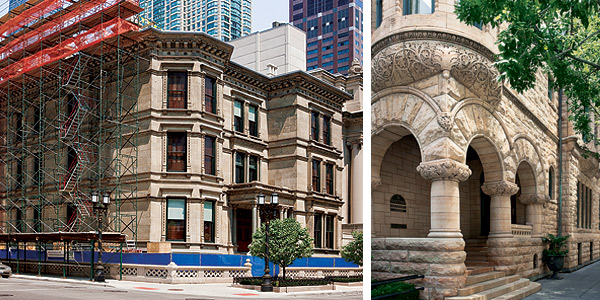
(Left) the exterior of the building after cleaning. The offices of Driehaus’s financial firm are diagonally across the street from the museum in a compound that consists of two historic houses—the 1886 Ransom Cable mansion (right) and a century-old brick townhouse formerly occupied by the architecture firm of Graham, Anderson, Probst & White.
This is quite a jump from where Driehaus began. He grew up on the Southwest Side in a classic octagon-front brick bungalow, the son of a mechanical engineer. His father, Herman, developed Alzheimer’s disease in his fifties, forcing his mother, Margaret, to return to work as a secretary at the Automatic Transportation Company. The family, while not poor, never had much disposable income.
By most accounts, Driehaus was a shy child. “He was not the extrovert he is today,” says Dorothy Driehaus Mellin, the elder of Driehaus’s two sisters. “I was the one who would be out dating, and he would wait up to make sure everything went well.”
“He always had a strong aesthetic sense,” she adds. “I used to help him on his paper route, and he would talk about the different houses—what he liked about this window or that style of brickwork.”
The Roman Catholic Church played a large role in the family’s life, and Driehaus attributes much of his later philanthropic bent to the lessons he absorbed from the nuns at the St. Margaret of Scotland grammar school. “In addition to reading, writing, and arithmetic,” he says, “they taught me three things—you have to continue to learn your whole life, you have to be responsible for your own actions, and you have to give something back to society.”
Driehaus has more than repaid the debt. Among his major grants to Catholic charities and causes are $1 million apiece to Old St. Pat’s, St. Margaret’s, St. Ignatius College Prep, and the Sisters of Notre Dame School in Berwyn.
An odd thing happened when he was 13, however—odd, at least, by the standards of a teenager—when he suddenly became obsessed with the stock market. He made his first investments using money he had earned as a paperboy delivering the Southtown Economist.
After graduating from DePaul University with an MBA, he became a research analyst and stock picker for firms such as Rothschild & Company, A. G. Becker, and Jesup & Lamont before going out on his own.
Did he ever consider becoming an architect? “No. It’s too complex and difficult,” he says. “It’s not my skill set.”
Architecture, however, remains his abiding passion. At his birthday party last summer, Driehaus concluded his remarks by quoting two 19th-century eminences who, collectively, sum up his approach to the art and business of historic preservation. The first is the British architectural critic John Ruskin, who tended to take the long view. “Let it not be for present delight, nor for present use alone,” he wrote. “Let it be such work as our descendants will thank us. . . .”
The second is P. T. Barnum, a considerably less exalted figure but one whose wisdom may prove handy in the coming months. “Without promotion,” said Barnum, “something terrible happens . . . nothing!”
Photography: William Zbaren


